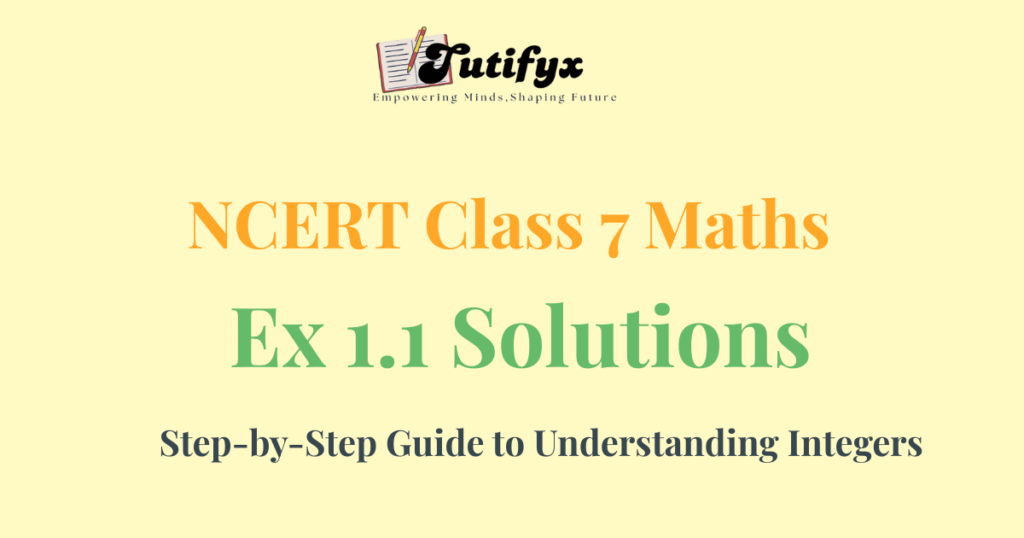class 7 maths ex 1.1 solutions
If you’re looking for clear, step-by-step explanations to all the questions in Ex 1.1 Class 7 Maths, you’re in the right place. In Tutifyx, you will get the solutions of all the problems from Class 7 Maths Ex 1.1 Solutions with easy-to-follow logic, helpful hints, and neat formatting—perfect for quick revision or deeper understanding. These solved answers of NCERT Class 7 Maths Chapter 1 Integers Ex 1.1 will make learning integers fun and simple!
Exercise 1.1 Class 7 Maths | Integers
Ques 1: Write down a pair of integers whose:
- sum is –7
- difference is –10
- sum is 0
Solutions:
(a) Sum is –7
Let the two integers be –4 and –3.
Now,
= –4 + (–3)
= –4 – 3
= –7
Hence, –4 and –3 is a required pair.
(b) Difference is –10
Let the two integers be 3 and 13.
Now,
= 3 – 13
= –10
Hence, 3 and 13 is a required pair.
(c) Sum is 0
Let the two integers be 6 and –6.
Now,
= 6 + (–6)
= 6 – 6
= 0
Hence, 6 and –6 is a required pair.
Ques 2: (a)Write a pair of negative integers whose difference gives 8.
(b) Write a negative integer and a positive integer whose sum is –5.
(c) Write a negative integer and a positive integer whose difference is –3.
Solutions:
(a) Let the two negative integers be –2 and –10.
Now,
= (–2) – (–10)
= –2 + 10
= 8
Hence, –2 and –10 is a required pair.
(b) Let the negative integer be –9 and the positive integer be 4.
Now,
= –9 + 4
= –5
Hence, –9 and 4 is a required pair.
(c) Let the negative integer be –5 and the positive integer be –2.
Now,
= –5 – (–2)
= –5 + 2
= –3
Hence, –5 and –2 is a required pair.
Ques 3: In a quiz, team A scored – 40, 10, 0 and team B scored 10, 0, – 40 in three successive rounds. Which team scored more? Can we say that we can add integers in any order?
Solution:
Scores of Team A = –40, 10, 0
Total score of Team A
= –40 + 10 + 0
= –30 + 0
= –30
Scores of Team B = 10, 0, –40
Total score of Team B
= 10 + 0 + (–40)
= 10 – 40
= –30
Both teams scored –30.
So, both teams scored the same.
Also, the scores were the same even though the order of the integers was different.
Hence, yes, we can add integers in any order.
This is because the addition of integers is commutative, i.e., a + b = b + a
Question 3: Fill in the blanks to make the following statements true:
(i) (–5) + (– 8) = (– 8) + (…………)
(ii) –53 + ………… = –53
(iii) 17 + ………… = 0
(iv) [13 + (– 12)] + (…………) = 13 + [(–12) + (–7)]
(v) (– 4) + [15 + (–3)] = [– 4 + 15] + …………
(i) (–5) + (– 8) = (– 8) + (…………)
Property used: Commutative Property of Addition
Formula: a + b = b + a
Solution: a= -5, b= -8
(–5) + (– 8) = (– 8) + (-5 )
(ii) –53 + ………… = –53
Property used: Additive Identity Property
Formula: a + 0 = a
Solution: Let a = –53
(–53) + 0 = –53
(iii) 17 + ………… = 0
Property used: Additive Inverse Property
Formula: a + (–a) = 0
Solution: Let a = 17
17 + (–17) = 0
(iv) [13 + (– 12)] + (…………) = 13 + [(–12) + (–7)]
Property used: Associative Property of Addition
Formula: (a + b) + c = a + (b + c)
Solution: Let a = 13, b = –12, c = –7
[13 + (–12)] + (–7) = 13 + [(–12) + (–7)]
(v) (– 4) + [15 + (–3)] = [– 4 + 15] + …………
Property used: Associative Property of Addition
Formula: a + (b + c) = (a + b) + c
Solution: Let a = –4, b = 15, c = –3
(–4) + [15 + (–3)] = [–4 + 15] + (–3)
Hope these step-by-step explanations for Ex 1.1 Class 7 Maths made the concepts of integers easier to understand. Each solution in this guide is carefully written to help students score full marks and build a strong foundation in mathematics. Whether you’re revising before an exam or completing your classwork, these NCERT Class 7 Maths Ex 1.1 Solutions are here to guide you at every step. Keep practicing, stay curious, and math will become your favorite subject in no time!

